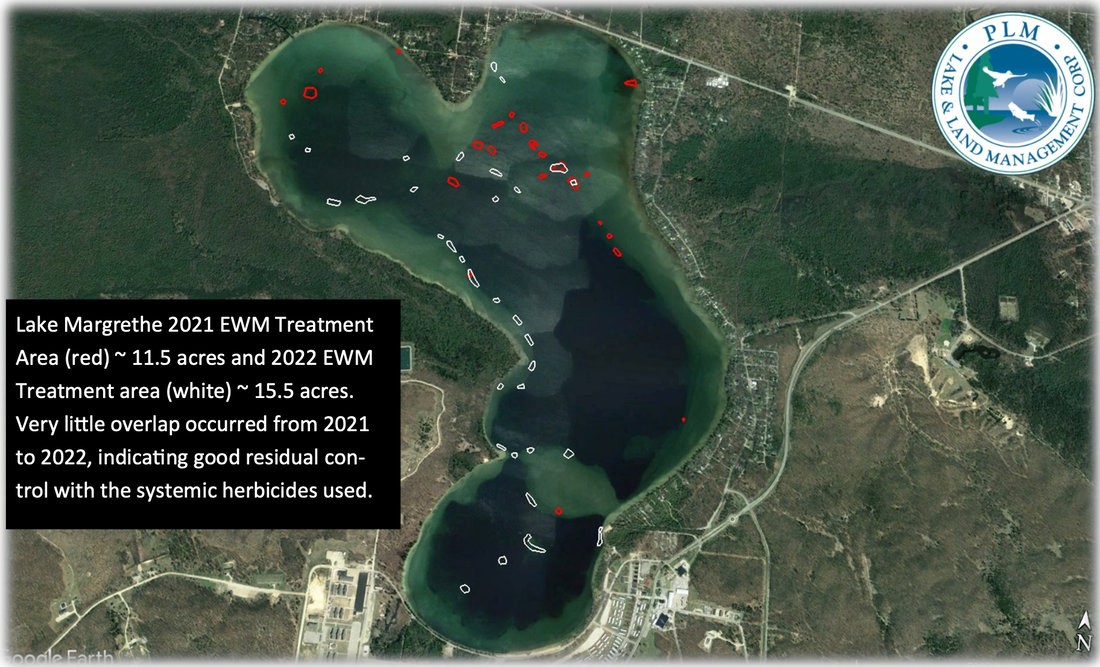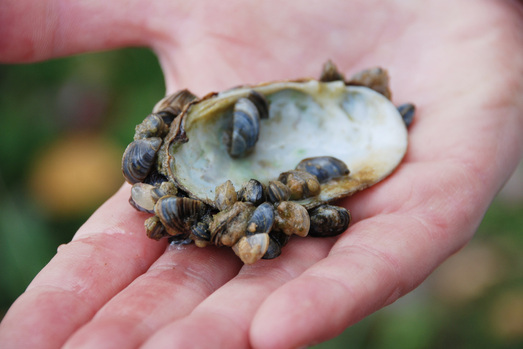Invasive Species
Lake Margrethe Eurasian Milfoil Treatment
Lake Margrethe was again treated for Eurasian milfoil in August 2022, by the Professional Lake Management Company of Howard City, Michigan. Our lake was treated extensively in 2020 following a non-treatment period of 4 years (due to changes in the law and the need for the Special Assessment District, SAD). Milfoil growth had spread dramatically. The 2020 and 2021 treatments included a state of art GPS survey to identify and locate as many milfoil beds as possible. In 2020 Professional Lake Management located 51 acres which required treatment. The total bill for the 2020 invasive treatment was $35,433.63 and that bill was divided between the Lake Margrethe Special Assessment District (SAD), the Lake Margrethe Foundation, and the Michigan Department of Military and Veterans Affairs. Each of those sponsors paid $11,811.21 to the Charter Township of Grayling, the supporting agency of the Lake Margrethe SAD. The treatment area of 51 acres, which included the Harbor Beach canal, is the largest area we have ever treated. Although we will never totally eliminate Eurasian Milfoil and Lake Margrethe will require continuing treatments to control the growth and spread of this invasive plant we are happy to report incredible results from the 2020 treatment. Below is a comparison map. Red is where milfoil was found in 2020 and yellow is where milfoil was found and treated this year. It is impossible to know what Lake Margrethe would look like now if we had failed to begin treatments in 2003.
Following the first map is a comparison of 2021 vs. 2022. Again the cost ($12.550.66) was split between the guard, LMPOA and SAD.
Lake Margrethe was again treated for Eurasian milfoil in August 2022, by the Professional Lake Management Company of Howard City, Michigan. Our lake was treated extensively in 2020 following a non-treatment period of 4 years (due to changes in the law and the need for the Special Assessment District, SAD). Milfoil growth had spread dramatically. The 2020 and 2021 treatments included a state of art GPS survey to identify and locate as many milfoil beds as possible. In 2020 Professional Lake Management located 51 acres which required treatment. The total bill for the 2020 invasive treatment was $35,433.63 and that bill was divided between the Lake Margrethe Special Assessment District (SAD), the Lake Margrethe Foundation, and the Michigan Department of Military and Veterans Affairs. Each of those sponsors paid $11,811.21 to the Charter Township of Grayling, the supporting agency of the Lake Margrethe SAD. The treatment area of 51 acres, which included the Harbor Beach canal, is the largest area we have ever treated. Although we will never totally eliminate Eurasian Milfoil and Lake Margrethe will require continuing treatments to control the growth and spread of this invasive plant we are happy to report incredible results from the 2020 treatment. Below is a comparison map. Red is where milfoil was found in 2020 and yellow is where milfoil was found and treated this year. It is impossible to know what Lake Margrethe would look like now if we had failed to begin treatments in 2003.
Following the first map is a comparison of 2021 vs. 2022. Again the cost ($12.550.66) was split between the guard, LMPOA and SAD.
Eurasian Milfoil
 Northern Eurasian Milfoil
_Eurasian milfoil is an extremely aggressive exotic aquatic macrophyte that is considered to be problematic to native plant and animal species. Milfoil forms very dense mats of vegetation which compete with and crowd out native aquatic plants. Eurasian milfoil starts spring growth sooner than native aquatic plants. As a result, milfoil robs oxygen and sunlight from native species. Fish species are also adversely affected by this change in plant growth. While some species of waterfowl will eat milfoil, it is not considered to be a good food source. Dense mats of Eurasian milfoil can also interfere with recreational activities, create a good habitat for mosquitoes, and trap sediments.
Eurasian milfoil, which was once commonly sold as an aquarium plant, originates from Europe and Asia, but was introduced to North America many years ago and is now found over much of the United States. Milfoil is able to reproduce very successfully and rapidly through the formation of plant fragments. In the late summer and fall the plants become brittle and naturally break apart. These fragments will float to other areas, sink, and start new plants. A new plant can start from a tiny piece of a milfoil plant. This is why milfoil can so easily be transported from lake to lake on boat trailers or fishing gear. There are multiple species of milfoil, so identifying an individual species can prove to be difficult. Here are some tips to identify Eurasian milfoil from the native milfoils.
|
Help Needed!
LMPOA needs your help to combat milfoil in Lake Margrethe! We have hired PLM, Professional Lake Management, to help us identify and treat the larger beds of milfoil in the lake. You can also contribute to the milfoil fund. Click here. We are always looking for volunteers! If you are interested, please email Sandra at [email protected]
Zebra Mussels
The Zebra Mussel is a small freshwater mussel. This species was originally native to the lakes of southeast Russia, however, it has been accidentally introduced in many other areas. Zebra Mussels were first introduced to the Great Lakes in 1988. Zebra Mussels get their name from a striped pattern which is commonly seen on their shells, though not all shells bear this pattern. They are usually about the size of a fingernail, but can grow to a maximum length of nearly 2 inches. Zebra Mussels attach to most substrates including sand, silt, and rock. Zebra Mussels frequently attach to, and often kill species of native mussels.
Effects of the Zebra Mussel on the ecosystems of Michigan lakes are conflicting. Zebra Mussels can grow so densely that they can cause damage to boats, buoys, and waterways. They are also believed to be the source of deadly avian botulism poisoning, which has killed tens of thousands of birds in the Great Lakes since the late 1990's. They are also responsible for the near extinction of many species by out-competing native species for food and by attaching to native clams and mussels. However, Zebra Mussels are also credited with increased populations of Smallmouth Bass and Yellow Perch in some areas, due to the fact that these species eat the mussels. Zebra Mussels are also extremely productive filter-feeders and as a result, they filter out pollutants. Therefore, Zebra Mussels can actually increase water visibility. |



